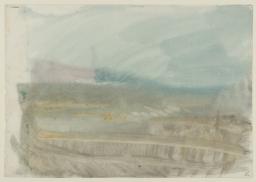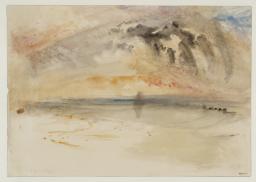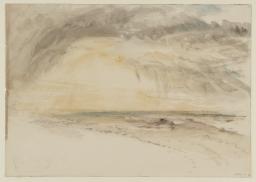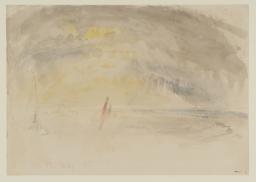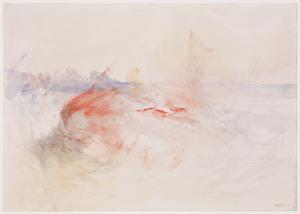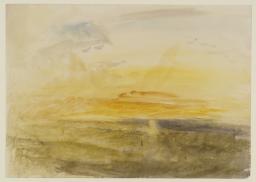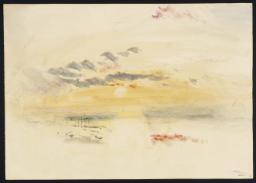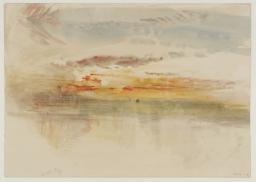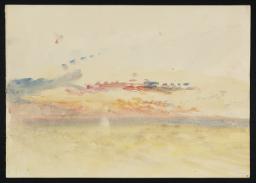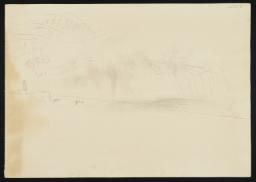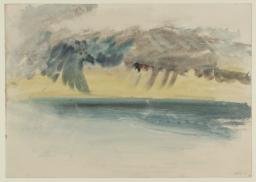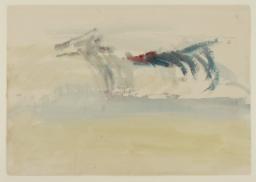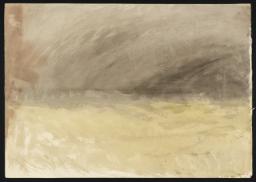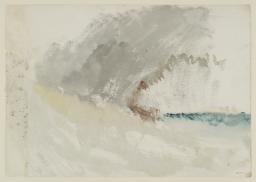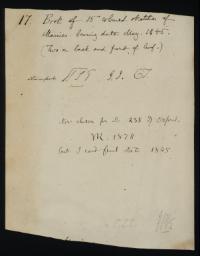Turner Bequest CCCLVII 1–14
Accepted by the nation as part of the Turner Bequest 1856
Exhibition history
References
The Ambleteuse and Wimereux sketchbook is one of the two known ‘roll sketchbooks’ that accompanied Turner on a restorative trip to northern France in May 1845, as discussed in the Introduction to this tour. Pencil inscriptions on three sketches date them with unusual exactness to 12 May 1845 (D25387, D25388, D25390; Turner Bequest CCCLVII 2, 3, 5). Although the other sketchbook remains intact (Boulogne; Tate; Turner Bequest CCCLVIII), the pages of the Ambleteuse and Wimereux sketchbook were removed from the ‘red cloth covers’ described by A.J. Finberg in his 1909 Inventory1 at some point in the twentieth century, and are now a collection of loose pencil and watercolour sketches depicting the quiet coastal region around Boulogne. Nonetheless, the sequence in which the works appeared in the sketchbook has been preserved by John Ruskin’s red ink foliation on each page as set out by Finberg;2 the relationship between individual sketches in their original order can therefore be kept in mind.
Ambleteuse and Wimereux were coastal villages north of Boulogne upon which centuries of English hostilities had left multiple physical traces. The eighteenth-century Tour de Croy, an offshore fort near Wimereux, appears on at least one occasion in the sketchbook (D35387, D35394; Turner Bequest CCCLVII 2, 9)3 as do the rather more substantial seventeenth-century defences at Ambleteuse (D35390; Turner Bequest CCCLVII 5).4 Both settlements had declined significantly in prosperity during the post-Napoleonic peace and by the 1840s amounted to little more than a ‘sorry hamlet’ and a ‘wretched fishing village’.5 The modest fishing vessels that sail singly or in pairs in these sketches or stand idly on the beach reflect the small-scale industry that now sustained these former garrisons.
The atmospheric effects of a distinctively coastal meteorology are the major concern of the sketchbook. As a token of this, Robert Upstone notes that Turner uncharacteristically drew the outline of clouds in several instances here although the application of loose watercolour washes over brief pencil annotations is otherwise typical of the ‘roll sketchbooks’.6 Towards the beginning of the sketchbook as numbered, the compositional possibilities of grey cloud arching over a horizon of glowing yellow are developed over three successive pages (D35388–D35390; Turner Bequest CCCLVII 3–5). A series of four richly tinted sea views occupies the central section featuring a low sun scattering blue, yellow, and pink light across distant clouds and waves (D35392–D35395; Turner Bequest CCCLVII 7–10). The sketchbook closes with six depictions of dark rainclouds breaking over variously calm and choppy waters (D35396–D35401; Turner Bequest CCCLVII 10a–CCCLVII 14).
In depicting a moment in the heat of a whale hunt, D35391 (Turner Bequest CCCLVII 6) is exceptional in this sketchbook although, as discussed in the entry for that piece, a comparable scene (or possibly two) may have been removed before it entered the national collection. Robert K. Wallace speculates that the unidentified object in D35399 (Turner Bequest CCCLVII 12) is an eyewitness account of a whale’s back emerging from the waves.7 He further observes the resemblance between the butchered carcases of those animals and certain cloud and rain formations amongst the meteorological sketches (D35397, D35399; Turner Bequest CCCLVII 11, 12).8 Seeking broader thematic connections between the exceptional D35391 and the rest of the sketchbook, David Blayney Brown ventures that its ‘melancholy’ subject, redolent of Turner’s own state of mind at this time, is of a piece with the ‘meditative, withdrawn and silent atmosphere’ pervading these ‘impressions of a deserted coastline’.9
Pierre-André Wimet, ‘Un vestige boulonnais de la Guerre de Sept ans – La tour de Croy, à Wimereux’, Bulletin de la Commission Départementale des Monuments Historiques du Pas-de-Calais, vol.6, no.1, 1935, pp.418–22.
See Jean-Denis G.G. Lepage, French Fortifications, 1715–1815: An Illustrated History, Jefferson NC 2010, p.188.
Robert Upstone, Turner: The Final Years: Watercolours 1840–1851, exhibition catalogue, Tate Gallery, London 1993, p.56.
Robert K. Wallace, Turner & Melville: Spheres of Love and Fright, Athens [Georgia] and London 1992, pp.537–8.
Technical notes
How to cite
John Chu, ‘Ambleteuse and Wimereux Sketchbook 1845’, sketchbook, December 2013, in David Blayney Brown (ed.), J.M.W. Turner: Sketchbooks, Drawings and Watercolours, Tate Research Publication, April 2015, https://www

